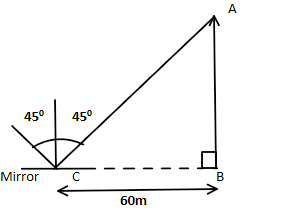
A plane mirror is placed on level ground at a distance $60m$ from the foot of a tower, the ray coming from the top of the tower and its reflected ray from the mirror subtends an angle $90^\circ $. What is the height of the tower?
A) $30m$
B) $60m$
C) $90m$
D) $120m$
Answer
134.4k+ views
Hint:When a plane mirror reflects a ray of light, the angle of reflection is always equal to the angle of incidence. The ray of incidence, reflection and the normal all lie on the same plane. This principle will help us solve the problem in hand. If an incident ray subtends a certain angle then this means that that angle represents the sum of both reflected angle and incident angle.
Complete step by step solution:
Let’s first analyse the scenario. The mirror is at a distance of $60m$ from the foot of the tower.
The incident ray from the top of the tower will hit the mirror to subtend an angle of $90^\circ $. This means that when the incident ray, coming from the tip of the tower hits the mirror it creates a $45^\circ $ angle with the normal and the angle of reflection is $45^\circ $. This is because reflection is based on the principle that angle of reflection is equal to the angle of incidence.
Let’s look at the following figure for better understanding.

From the figure we can see that in the right angled triangle $\vartriangle ABC$ the value of angle $\angle C$ is $45^\circ $.
This implies that the right-angled triangle is an isosceles triangle too. So the lengths of arms $\overline {AB} $ and $\overline {BC} $ are equal.
So the height of the tower will be $\left| {\overline {AB} } \right| = \left| {\overline {BC} } \right| = 60m$
Thus our correct answer is option (B).
Note:Any kind of reflecting surface works on the principle that angle of incidence is equal to angle of reflection. In some cases we might need to use trigonometric calculations in order to find an angle or length of an arm.
Complete step by step solution:
Let’s first analyse the scenario. The mirror is at a distance of $60m$ from the foot of the tower.
The incident ray from the top of the tower will hit the mirror to subtend an angle of $90^\circ $. This means that when the incident ray, coming from the tip of the tower hits the mirror it creates a $45^\circ $ angle with the normal and the angle of reflection is $45^\circ $. This is because reflection is based on the principle that angle of reflection is equal to the angle of incidence.
Let’s look at the following figure for better understanding.

From the figure we can see that in the right angled triangle $\vartriangle ABC$ the value of angle $\angle C$ is $45^\circ $.
This implies that the right-angled triangle is an isosceles triangle too. So the lengths of arms $\overline {AB} $ and $\overline {BC} $ are equal.
So the height of the tower will be $\left| {\overline {AB} } \right| = \left| {\overline {BC} } \right| = 60m$
Thus our correct answer is option (B).
Note:Any kind of reflecting surface works on the principle that angle of incidence is equal to angle of reflection. In some cases we might need to use trigonometric calculations in order to find an angle or length of an arm.
Recently Updated Pages
JEE Main 2025 Session 2 Form Correction (Closed) – What Can Be Edited

What are examples of Chemical Properties class 10 chemistry JEE_Main

JEE Main 2025 Session 2 Schedule Released – Check Important Details Here!

JEE Main 2025 Session 2 Admit Card – Release Date & Direct Download Link

JEE Main 2025 Session 2 Registration (Closed) - Link, Last Date & Fees

JEE Mains Result 2025 NTA NIC – Check Your Score Now!

Trending doubts
JEE Main 2025 Session 2: Application Form (Out), Exam Dates (Released), Eligibility, & More

JEE Main 2025: Conversion of Galvanometer Into Ammeter And Voltmeter in Physics

JEE Main 2025: Derivation of Equation of Trajectory in Physics

Wheatstone Bridge for JEE Main Physics 2025

Degree of Dissociation and Its Formula With Solved Example for JEE

Electric field due to uniformly charged sphere class 12 physics JEE_Main

Other Pages
JEE Advanced Marks vs Ranks 2025: Understanding Category-wise Qualifying Marks and Previous Year Cut-offs

Diffraction of Light - Young’s Single Slit Experiment

Dual Nature of Radiation and Matter Class 12 Notes: CBSE Physics Chapter 11

Electric Field Due to Uniformly Charged Ring for JEE Main 2025 - Formula and Derivation

Elastic Collisions in One Dimension - JEE Important Topic

Formula for number of images formed by two plane mirrors class 12 physics JEE_Main




